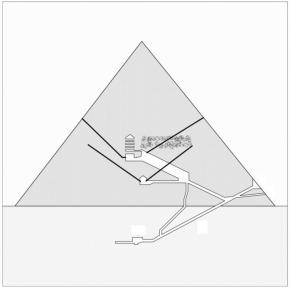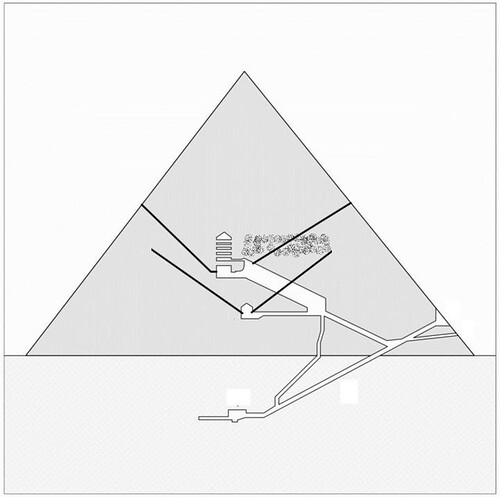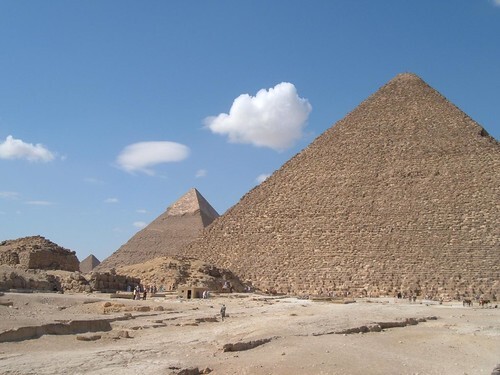
POLITECNICO DI MILANO—In early November 2017, Nature published the results of the Scan Pyramids project, led by Mehdi Tayoubi (Hip Institute, Paris) and Kunihiro Morishima (University of Nagoya, Japan): there is a “huge void”, at least 30 meters long, within the Pyramid of Cheops.
Discovering its function and content clearly is a most passionate challenge for archaeologists.
Giulio Magli, Director of the Department of Mathematics and Professor of Archaeoastronomy at the Politecnico di Milano, has formulated one of the first hypotheses of interpretation.
“Cheop’s Pyramid, built around 2550 BC, is one of the largest and most complex monuments in the history of architecture. Its internal rooms are accessible through narrow tunnels, one of which, before arriving at the funerary chamber, widens and rises suddenly forming the so-called Great Gallery. The newly discovered room is over this gallery, but does not have a practical function of “relieving weight ” from it, because the roof of the gallery itself was already built with a corbelled technique for this very reason.”
So what does that mean?
“There is a possible interpretation, which is in good agreement with what we know about the Egyptian funerary religion as witnessed in the Pyramids Texts. In these texts it is said that the pharaoh, before reaching the stars of the north, will have to pass the “gates of the sky” and sit on his “throne of iron”.
Within the Pyramid there are four narrow shafts, the width of a handkerchief, directed to the stars. The pharaoh’s afterlife was in fact, according to the Texts, in the sky, and in particular among the stars of the north, like the Big Dipper and Draco. Two of the four channels open onto the facades of the monument, while the other two run into small doors. One of the two doors, the south one, has been explored several times without results, while the north one is still sealed.
These doors are with all probabilities representative of the “gates of the sky” and the north one could well lead into the newly discovered room. The room may contain, at its upper end and exactly under the apex of the great pyramid, an object needed by Cheops after crossing the doors: the “iron throne” mentioned in the Pyramid Texts.
We can get an idea of how this object could be, looking at the throne of Cheop’s mother, Queen Hetepheres, which has been found in pieces and reconstructed by Harward University. It is a low chair of cedar wood covered with sheets of gold and faience. Cheops’ could be similar, but coated with thin iron sheets. Of course it would not be melted iron, but meteoritic iron that is, fallen from the sky in the form of Iron meteorites (distinguishable due to the high percentage of the element Nickel) and again cited in the Texts. It is certain that the Egyptians knew this material for many centuries before Cheops, and continued to use it for special items designed for the Pharaohs during millennia: just think of the famous Tutankamon dagger.
A way to check or discard this hypothesis exists: a new exploration of the north shaft. This is a long-awaited exploration, long before the room’s discovery. At present, it is difficult to say with certainty that the northern channel leads into the newly discovered room – the “big void” as called by its discoverers – because the available images are approximate. The Scan Pyramid project indeed used a non-invasive technique based on the measurement of muons: elementary particles that are generated in cosmic rays and are absorbed differently depending on the materials they go through. The result is similar to a radiography which must be interpreted.
_________________________________
North-south section of the Great Pyramid showing (dust-filled area) the hypothetical chamber, in connection with the lower southern shaft. The upper southern shaft does not intersect the chamber (as instead suggested by the section) because, when viewed in plan, it is displaced to the west with respect to the Great Gallery. Giulio Magli
_________________________________________
A view of the Giza Pyramids from the east with the Great Pyramid in the foreground. Giulio Magli
Article Source: POLITECNICO DI MILANO news release
____________________________________________
Become a new Popular Archaeology premium subscriber.
___________________________________________
Travel and learn with Far Horizons.
______





